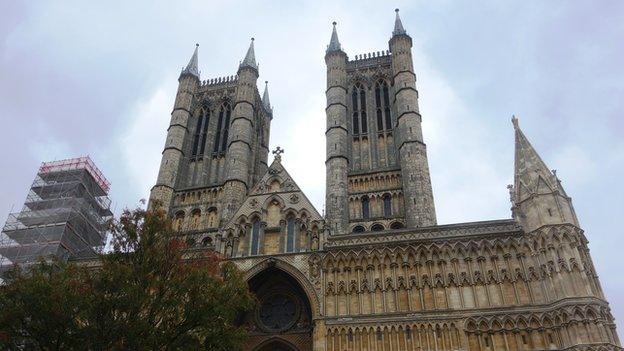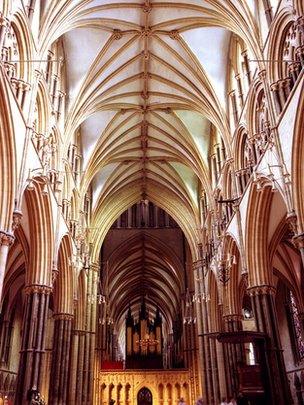The business of cathedrals: Mixing finance with worship
- Published

Building work on Lincoln Cathedral started in 1088
Just sometimes there are moments when a reporter escapes the confusion of the here and now, when the present merges with the past in a numinous concurrence. Even when you are reporting on business.
It happened the other day, in Lincoln. I grew up in Lincolnshire; I can remember first visiting Lincoln Cathedral when I was eight: 60 years ago.
It is stupendous, of course. The Victorian critic John Ruskin called it "out and out, the most precious piece of architecture in the British Isles, roughly speaking worth any two other cathedrals we have".
Construction started more than 900 years ago, and the building is extraordinary: high drama in stone.
The cathedral stands as a beacon in the Lincolnshire countryside. On a clear day you can see it from 20 or 30 miles away. It sits like a vast lid on top of the whole city.
A childhood tale
In 1957 I went to boarding school in Lincoln. I was 10, away from home for the first time. On the first weekend, the headmaster led the new boarders to the cathedral.

The cathedral is an architectural treasure
When we got there, the head led our little group across the east transept to a little door which is still there on the left. (He obviously had friends in high places.)
We clambered up a winding flight of stairs, a long way. The group paused at the top, and the head walked cautiously out into what seemed like space. This was the ledge at the base of what was now a vast round piece of mediaeval glass: the Dean's Eye.
One by one, we new boys were sent out, gingerly, along the ledge. "Don't hold the rail," said the cathedral official who was with us. "It's not too secure."
When we had reached the headmaster stationed at the very centre of that magnificent blaze of glass, he told each of us to turn to face the window, so our backs faced the drop of 50 feet or more to the minster floor below us.
And then, ignoring the dizzying abysm behind us, the head told us the story of St Hugh, as depicted there in front of us in the stained glass. An unforgettable confrontation with medieval Lincoln, on a sunny September afternoon in 1957.
I told the story in the minster at a University of Lincoln graduation ceremony in September 2009, almost 52 years to the day after it happened.
The university had been kind enough to award me an honorary doctorate of business administration.
By way of saying "thank you" I recalled that previous Lincoln encounter with the vivid past, and how it impressed upon me the significance of story-telling... which is what I had sort of grown up to do in radio.
Centuries-old business
Five years later, in November, I found myself back in the cathedral to make a programme on the business of cathedrals.
In the gloom of a winter afternoon I walked round the whole outside length of the cathedral exterior to meet the dean, the Very Reverend Philip Buckler. He's the priest in charge of the whole place.

The cathedral currently has a 20-year plan for its renovations
When we were almost at the deanery, I recognised where we were heading: what had been in my time the chancellor's house, the place where I had confirmation classes in 1960.
In the course of the interview, the dean spoke of the great continuity of the cathedral, its fabric and its worship. If cathedrals are businesses (and they are), not many businesses have a 900-year perspective.
The dean told me that the cathedral has a specific 20-year plan for renovation works: exactly what stonemasons and glaziers will be doing year by year. But that is within the context of a much longer 100-year plan.
When the work is done, the craftspeople don't want to be back for a century. The cathedral also has its own quarry, so that new stone matches the original.
Like many cathedrals, Lincoln is on English Heritage's "at risk" list. The organisation says the cathedral needs to spend about £1.5m a year to repair and restore itself.
Daunting to an always hard-up Church of England, but not something the people who run the cathedral can shirk. "The building is part of the ministry and the message", says the dean.
But cathedrals are so splendid that it easy to feel that visitors - and even staff, perhaps are worshipping the building, not God.
Always a danger, says the dean, but because worship and liturgy and music are at the heart of what the cathedral does, that focuses the hearts and minds of those who run and use the cathedral.
What other business can call on that sort of dedication?
And then the dean mentioned the tradition very special to Evensong in Lincoln, when priest and congregation remember in prayer people associated with the place who "died on this day in..." often hundreds of years before.
It is a moment that makes the nape of your neck prickle.
And, he says, it puts the concerns of today - personal, the issues the church faces today, that great building and its running - into the vast context of eternity.
These great cathedrals stand for something greater than themselves.
Sure enough, an hour or so later, during the beautiful service on the Friday I was there, we prayed for Queen Eleanor of Castile, wife of Edward I, "who died on this day in the year 1290, and whose remains are buried in the Angel Choir."
And suddenly once again time present and time past rolled back into one. An extraordinary moment, but it happens in Lincoln evening after evening.
Peter Day's programme on the business of cathedrals, For Ever and Ever, is available via the BBC iPlayer Radio, and also on Global Business on the BBC World Service website.